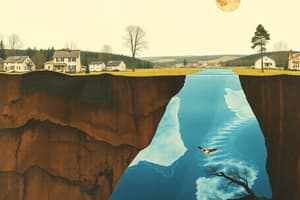Podcast
Questions and Answers
Explain how the characteristics of both confined and unconfined aquifers affect their vulnerability to pollution.
Explain how the characteristics of both confined and unconfined aquifers affect their vulnerability to pollution.
Confined aquifers are generally less vulnerable due to protective layers of clay or rock, while unconfined aquifers are more susceptible because they're open to surface water and rainfall.
Describe how the water cycle is integral to the replenishment and sustainability of aquifer systems.
Describe how the water cycle is integral to the replenishment and sustainability of aquifer systems.
Precipitation infiltrates the soil, replenishing groundwater within aquifers, which then discharge water through springs, eventually evaporating back into the atmosphere to complete the cycle.
Discuss the potential long-term consequences of over-pumping an aquifer, considering both environmental and economic impacts.
Discuss the potential long-term consequences of over-pumping an aquifer, considering both environmental and economic impacts.
Over-pumping can lead to depletion of the aquifer, land subsidence, reduced water quality, increased costs for water extraction, and potential harm to ecosystems that depend on the aquifer's discharge.
How might climate change affect the recharge rates of aquifers, and what strategies can be implemented to mitigate these effects?
How might climate change affect the recharge rates of aquifers, and what strategies can be implemented to mitigate these effects?
Explain how understanding the geology of an area is crucial for effective aquifer management and protection.
Explain how understanding the geology of an area is crucial for effective aquifer management and protection.
Describe the roles of hydrogeologists and environmental engineers play in ensuring the sustainable use and protection of aquifer resources.
Describe the roles of hydrogeologists and environmental engineers play in ensuring the sustainable use and protection of aquifer resources.
Critically evaluate the different methods used to study aquifers, highlighting the strengths and limitations of each.
Critically evaluate the different methods used to study aquifers, highlighting the strengths and limitations of each.
Discuss the significance of community education in promoting aquifer conservation and responsible water use.
Discuss the significance of community education in promoting aquifer conservation and responsible water use.
Flashcards
What is an Aquifer?
What is an Aquifer?
An underground layer of rock, gravel, sand, or sediment that holds water.
Confined Aquifer
Confined Aquifer
An aquifer protected by layers of clay or rock.
Unconfined Aquifer
Unconfined Aquifer
An aquifer open to surface water and rainfall.
Recharge Zone
Recharge Zone
Signup and view all the flashcards
Water Table
Water Table
Signup and view all the flashcards
Over-pumping
Over-pumping
Signup and view all the flashcards
Responsible water use
Responsible water use
Signup and view all the flashcards
Sustainable farming
Sustainable farming
Signup and view all the flashcards
Study Notes
- Aquifers are Earth's underground water storage.
What are Aquifers
- Aquifers are underground layers of rock, gravel, sand, or sediment.
- They hold water like a natural underground sponge, storing water in tiny spaces.
Types of Aquifers
- Confined aquifers are protected by layers of clay or rock.
- Unconfined aquifers are open to surface water and rainfall.
- Artesian aquifers are under pressure, causing water to rise naturally.
How Aquifers Form
- Water seeps through soil and rock layers to create aquifers.
- Aquifers fill spaces between rocks and sediments.
- Aquifer formation is a natural filtration process that takes hundreds to thousands of years.
Parts of an Aquifer System
- Recharge Zone: Area where water enters an aquifer.
- Confining Layer: Clay or rock barrier.
- Water Table: Top of the water-saturated zone.
- Discharge Area: Area where water naturally exits an aquifer.
The Water Cycle and Aquifers
- Precipitation falls on Earth and water infiltrates through the soil.
- Groundwater moves through the aquifer.
- Natural springs release water.
- Evaporation returns water to the atmosphere.
Important Aquifers in the United States
- Ogallala Aquifer (Great Plains).
- Edwards Aquifer (Texas).
- Floridan Aquifer (Southeast).
- Principal Aquifer (Mississippi Valley).
Uses of Aquifer Water
- Aquifer water is used as a drinking water supply.
- It can be used for agricultural irrigation.
- Aquifers support industrial processes, support ecosystems, and municipal water systems.
Threats to Aquifers
- Over-pumping poses threat to aquifers.
- Surface pollution, urban development, and climate change poses threat to aquifers.
- Agricultural chemicals contaminate aquifers.
Protecting Our Aquifers
- Must implement responsible water use.
- Must implement proper waste disposal and reduce chemical use.
- Smart urban planning and conservation efforts helps protect aquifers.
How We Study Aquifers
- Aquifers can be studied through well drilling, water quality testing, and geological surveys.
- They can be studied via ground-penetrating radar and computer modeling.
Aquifer Conservation
- Water-saving and sustainable farming practices help conserve aquifers.
- Pollution prevention, groundwater monitoring, and community education help conserve aquifers.
Amazing Aquifer Facts
- Some aquifers are millions of years old.
- The Ogallala Aquifer could fill Lake Erie 9 times.
- About 30% of Earth's freshwater is in aquifers.
- Certain aquifers house fossil water dating back to ice ages.
Career Connections
- Hydrogeologist, Environmental Engineer, Water Quality Specialist, Conservation Manager, and Agriculture Consultant.
Why Aquifers Matter
- Aquifers are essential for food production, supply clean drinking water, and support ecosystems.
- They function as a buffer against drought.
- Aquifers are critical for future generations.
Studying That Suits You
Use AI to generate personalized quizzes and flashcards to suit your learning preferences.
Related Documents
Description
Aquifers are underground layers that hold water like a sponge, storing it in tiny spaces. There are different types of aquifers such as confined, unconfined, and artesian. They are formed as water seeps through soil and rock layers and act as natural filtration.




